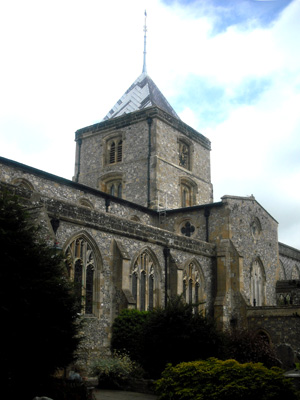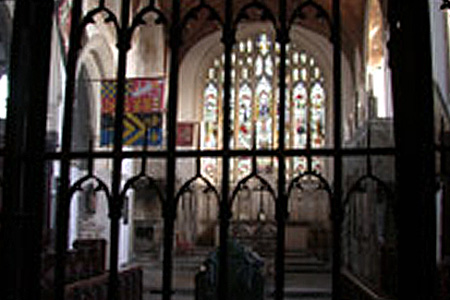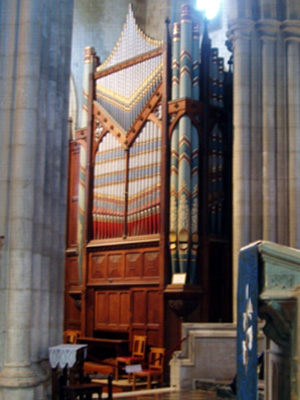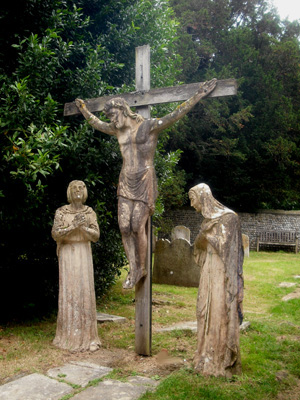| |
 |
 |
 |
| Comment on this report, or find other reports. |
 |
| Our Mystery Worshippers are volunteers who warm church pews for us around the world. If you'd like to become a Mystery Worshipper, start here. |
 |
| Find out how to reproduce this report in your church magazine or website. |
|
|
| 3059: St Nicholas, Arundel, England |
 |
 |
 |
Mystery Worshipper: Teutonic Knight.
The church: St Nicholas, Arundel, West Sussex, England.
Denomination: Church of England, Diocese of Chichester.
The building: A church dedicated to St Nicholas existed here during the time of Edward the Confessor. The Black Death caused it to fall into decay, but in 1380 a royal patent was granted to establish a college attached to the parish church. This building is the oldest surviving part of the current church. From the outside it looks like a cathedral, with a central tower, chancel, and sanctuary to the east and nave to the west, and north and south transepts. However, after the establishment of the college of priests, the chancel beyond the tower became their collegiate chapel and was separated by a locked grille from the rest of the building. Since then the two parts of the building have led a separate existence: the parish church is Anglican, while the former chancel became the private chapel of the Duke of Norfolk, who remained Roman Catholic. It is called the Fitzalan Chapel and can only be entered through the castle grounds that adjoin the church. The first time the grille was unlocked in over 400 years was in 1977, and it has been opened since on a handful of high-profile occasions, usually in the presence of royalty or Vatican officials. The carved stone pulpit in the Anglican half is unusually splendid. There are some traces of 14th century murals that survived first the Puritans, and then the Victorians, by being whitewashed. One depicts the Seven Works of Mercy, another the Seven Deadly Sins, and a third dates from the 15th century with the Virgin Mary as its centre piece. The Lady chapel has modern fittings, while in the churchyard you find three Calvary statues. The tower today houses a peal of eight bells.

The church: This church takes a unique place in the history of English churches in that it has united two denominations under one roof since before the days of modern ecumenism, albeit separated by an iron grille and glass screen. The parish has for over ten years entertained a German link with the Roman Catholic parish of the Immaculate Conception, Stegaurach, Bavaria, Germany, the first parish in the diocese to twin with a RC church abroad. They engage in reciprocal visits. St Nicholas are also involved in an international ecumenical educational project supporting a small rural community in South India. The parish has several groups aimed at children and youths, and there is evidence of their activities on display. The acclaimed musical ensemble The Hanover Band makes its home at St Nicholas and gives concerts throughout the year. The church also sponsors a barbershop quartet and a rock band.
The neighbourhood: Arundel is a picture-postcard town on the River Arun, one of the fastest flowing rivers in the country. Its castle is open to the public. The castle and RC cathedral on top of the hill dominate the skyline and the surrounding countryside. St Nicholas is located just opposite the cathedral – what a climb up the hill! The train station was opened in 1863, largely financed by the Duke of Norfolk on the condition that all trains to London stop here. They still do. There is boat hire on the river, and the ruins of a Blackfriars' (Dominican) priory dissolved by Henry VIII on the banks of the Arun. The town is a tea-shop, restaurant and antiques paradise.
The cast: The Revd David Twinley, vicar; the Revd Canon Brian E Cook, honorary assistant priest; the Revd Canon Robert Aiton, assistant priest; Pfarrer Walter Ries, pastor of the Church of the Immaculate Conception, Stegaurach, Germany. The altar party consisted of a young boat girl, master of ceremonies, a young crucifer, two young acolytes (one of whom very young), and a young lady carrying the gospel book. There was also a verger in full fig. There may have been some other priests – five more were mentioned in the intercessions – but I could not see them.
The date & time: Transfiguration of the Lord, 7 August 2016, 10.00am.
What was the name of the service?
Sung Eucharist.
How full was the building?
Comfortably full, with some people in the aisles of this cavernous building. I counted to about 120 without turning in all directions, but there were more. Up to 40 of them were Bavarians from their twin. There is an area at the back reminiscent of a box pew (with an open front) with toys for children and their parents, where they can play during the service. Some of the regulars kept turning around and casting dark looks at these little children, who could be heard but not seen. One of the children wore a Batman cloak and kept running up and down the aisle chased by a parent. During the peace I made a point of waving to them.
Did anyone welcome you personally?
Two people did. The first handed me the order of service with a few friendly words; the second, stationed at the bottom of the short flight of steps, shook my hand as well to words of welcome. This, for me, was a first.
Was your pew comfortable?
Standard Victorian, with a thin carpet runner that kept sliding when I moved until I was joined in my pew by five more people, when it bunched up. Leatherette kneelers, which I only saw one gentleman use. For ages the church was without pews, the faithful being obliged to bring their own chairs or remain standing. The old and infirm could avail themselves of a stone bench lining the walls, thus giving rise (in the minds of some, although scholarly evidence is lacking) to the expression "the weakest go to the wall."
How would you describe the pre-service
atmosphere?
I was 15 minutes early, and as the church slowly began to fill it got noisier. The organ started up, and, very briefly, pleasantly hushed the chatter. Alas, the chatter rose again to drown out all of the pre-service music, among which was "Prière à Nôtre Dame" from Suite Gothique by the 19th century French composer Léon Boëllmann. This is normally one of my favourite pieces to set me up for prayer and calm me before confession. Well, it failed to do any of this on this particular occasion.
What were the exact opening words of the
service?
"In the name of the Father, and of the Son, and of the Holy Spirit. My friends, a very warm welcome on this day when we celebrate the Transfiguration of Our Lord." Followed, in the same breath, by a short exposition on the importance and joy of the feast. It was difficult to work out where the sentence ended. A welcome in German followed.
What books did the congregation use during the
service?
A specially produced 24-page order of service. The readings were printed in English and German in parallel columns. It also contained a short write-up on the significance of the Transfiguration and its possible geographical setting. On the final few pages were notes of events planned for the coming weeks in the town as well as parish business.
What musical instruments were played?
There was a large robed choir of more than 20 singers, among them five men, and also a full front row of very young choristers. The three manual tracker organ is an opus of J M & C Corps of London dating from 1874. It still has some parts of the original instrument of 1817, probably built by William Gray. Last restored in 1991 by J W Walker & Sons Ltd, it was classed as "an instrument of importance to the national heritage" in June 2008 by the British Institute of Organ Studies.

Did anything distract you?
I wondered whether the German priest was Protestant or Catholic, as he was fully vested like his Anglican hosts, until he revealed himself as a Roman Catholic by his accomplished use of the thurible during the gospel procession. And the vicar could pass as the twin brother of the late Pope John Paul II.
Was the worship stiff-upper-lip, happy clappy, or
what?
The ceremonial was almost of cathedral quality, albeit not quite at the very top end of the Anglican candle: there were no bells at the consecration! I thought I had spotted a sanctus bell earlier, but perhaps I was mistaken. With a nod to the visitors, the first reading was delivered by a German-speaking member of the choir. The psalm was sung by a cantor, the response by the congregation. The second reading was also done by a member of the choir, this time in English. There was a full gospel procession with boat girl. The acclamation was also chanted by a cantor, while the congregation sang the response. The gospel was read in English by the German visiting priest, who otherwise attended in choir and did not take an active part in the liturgy. Like his Anglican counterparts he also was attired in chasuble, which did surprise me, considering he could not concelebrate. Curiously he substituted the name of Peter for Jesus, and I was wondering what translation he had been given, as our order of service gave the correct version. Intercessions were offered by another member of the choir (if you want a job in this church, join the choir!). The vicar made full use of the opportunity to sing most of the eucharistic prayer, and he could carry a tune.

Exactly how long was the sermon?
12 minutes.
On a scale of 1-10, how good was the preacher?
6 – It was a 5 for content, but a 8 for delivery. I was glad there was a high pulpit that allowed me to witness this spectacle; otherwise I would have missed a treat. If the vicar used notes, you would not have known it – he held eye-contact throughout and barely seemed to take a breath. He was very engaging in his theatrical performance. At times it was almost as though you were watching a story-teller or stand-up comedian with large gestures – the wagging or pointing finger, leaning forward in the pulpit as though he was going to take off, raising and lowering the voice effectively – and all delivered with a beaming smile. He lost me in the latter half of the sermon, however, when he compared Christianity to other religions and had not done his homework properly: Christianity is not the only religion based on a real historical person, nor have pagans, or indeed most religions, not suffered persecution.
In a nutshell, what was the sermon
about?
Father David invited us to let ourselves be transfigured by a gospel that is for everyone. He mainly referred to the second reading (2 Peter 1.16-18 – Peter witnessed the Transfiguration with his own eyes), and contrasted our faith to ancient mythology. Though mythology is essentially expressing fundamental truths, it is the Christian faith that is rooted in reality and history rather than ideas. While Zeus, Neptune and Narcissus reflect all-too-human qualities, it is Christianity that is based on the life and ministry of a real person. No one has ever been persecuted for the sake of Zeus, Neptune, or Narcissus, but even now, countless people are persecuted for their faith in Jesus Christ. No myth has had an eye-witness. History and truth, on the other hand, are about real people, places and events. The gospel records witnesses to the Transfiguration, the Resurrection, and miracles. People will suffer willingly for the sake of truth, and they still do at this very time in history.
Which part of the service was like being in
heaven?
It seemed that individual conscience beat official church doctrine when it came to communion – a glimpse of heaven indeed. The German visitors must have been Roman Catholic, but they received communion along with the Anglicans. I did not see a single person cross their arms for a blessing instead. The RC priest, however, did not receive.
And which part was like being in... er... the other place?
The two people who were without doubt the tallest in the entire congregation sat directly in my line of sight – I could neither see the altar, nor the credence table to the left, nor the lectern on the right, not even when I stood on my toes or performed acrobatics. Although I had arrived early and picked my place carefully, it all went to pots when a family of late arrivals bumped me along in the pew.
What happened when you hung around after the service looking lost?
It was almost impossible to get lost today, as the exit was effectively blocked by the swirling masses. I wandered around for a while, but among the German visitors who did the same this was not a good strategy. People were catching up with old friends and German visitors alike. I stood with some of the Germans and the time passed quickly. Two photographers with professional equipment circled to catch the spirit of this Anglo-German gathering. I hope the photos won't appear in the diocesan news and blow my cover.
How would you describe the after-service
coffee?
The visiting German priest had let the cat out of the bag in the final notices: it was Father David's birthday, and two cakes were not very discreetly decorated with his name and the big half century. There was also bubbly, but I think I did spot some spoilsports with coffee cups!
How would you feel about making this church your regular (where 10 = ecstatic, 0 = terminal)?
8 – If I lived here, I would be very comfortable with the liturgy, music, community engagement and ecumenical involvement. But it is probably a little bit too grand a parish church for my taste, and being expected to sing every Sunday after that lung-busting hill climb is a lot to ask of the flock.

Did the service make you feel glad to be a
Christian?
I was glad that international ecumenism is alive and well in this parish and that the laity are ahead of their "betters" in terms of Christian unity.
What one thing will you remember about all this in seven days' time?
A Pope John Paul II look-alike in the pulpit of an Anglican church. |
|
|
 |
 |
 |
| We rely on voluntary donations to stay online. If you're a regular visitor to Ship of Fools, please consider supporting us. |
 |
 |
 |
| The Mystery Pilgrim |
 |
| One of our most seasoned reporters makes the Camino pilgrimage to Santiago de Compostela in Spain. Read here. |
 |
 |
 |
| London churches |
 |
| Read reports from 70 London churches, visited by a small army of Mystery Worshippers on one single Sunday. Read here. |
| |
|
|
|
|


